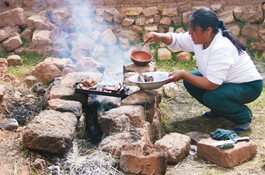
Argentina was christened “the land of silver,” by European explorers, dizzy with the prospect the country’s wealth of precious metals. Food lovers have another name for Argentina: “the land of beef” For them, Argentina’s greater wealth stands grazing on the hundreds of thousands of verdant acres in cattle country. Argentines consume more than 220 lbs of beef a year -- and is it any wonder? But Argentine cuisine merely begins with beef. A closer investigation reveals a marvelously diverse fusion of culinary traditions, reflecting Argentina’s considerable immigrant population, the second largest in the world after the United States. The largest groups are Mediterranean — Spanish and Italian — and much of the culinary traditions originate with these cuisines, but one can also detect from Japan, Poland, and Germany running through the country’s cuisine.
Argentines are expansive and generous hosts, and food takes center stage during long, convivial meals cooked over the
asado or outdoor barbecue. Lunch, particularly Sunday lunch, is the largest meal of the day, affording plenty of time for an unhurried lineup of courses that moves gradually from little appetizers to a triumphant crescendo of prime cuts of meat.
A meal may well begin with
provoleta, an Argentine riff on Italian provolone cheese, sliced in discs, then topped with fresh herbs such as oregano before being grilled until it is crisp on the outside and caramelized inside. While enjoying this overture, your host will be busy grilling small sausages made of pork (chorizo) or organ meats such as
mollejas made from sweetbreads. These are served alongside kidneys and chitterlings, with generous lashings of chimichurri, Argentina’s signature condiment: a tangy green salsa made from vinegar and fresh chopped herbs. Chimichurri is used interchangeably as a sauce and a marinade, and you may well detect it’s unmistakable flavor in the main cuts of meat that follow:
ojo de bife (rib-eye)
bife de chorizo (sirloin),
asado de tira (short ribs), and
entrane (skirt steak).
If you have a sweet tooth, Argentina is the place for you, with its irresistible,
dulce de leche (literally “milk jam”), a creamy concoction of caramelized condensed milk, employed generously throughout Argentina as both a sauce, poured over ice cream or custard, and as a filling for cakes, and the country’s famous empanadas.
No discussion of Argentine cuisine is complete without a closer look at the empanada. These ubiquitous, crescent-shaped pastries have stood the test of time and traveled far to become Argentina’s signature pastry. They originated in Muslim, Moorish Andalusia, where the use of strong African and Middle Eastern spices to preserve and flavor meat seeped into Christian Spanish cuisine. The Moors may have been expelled by Ferdinand and Isabella, but the empanadas remained, traveling north into Spain, and, from there on to the New World. What you find in an empanada depends on the province you are in: they may be filled with traditional chopped beef, mixed with corn and spices with cumin and spring onion, or sweet potato paste. Sweet empanadas contain
dulce de leche or cheese with quince paste called
membrillo.
And what do Argentines like to drink with their
asado and empanadas? Wine, of course, but beer is fast gaining in popularity, with new craft breweries such as Strange Brewing nipping at the heels of large, multi-national brands of Spanish
cerveza and Italian
birra. Finally, no trip to Argentina would be complete without sampling
mache, a heady mint tea brewed from the indigenous yerba mate plant. This energizing drink is traditionally served in a communal gourd and drunk through a communal straw called a
bombilla. It may not be hyper hygienic by American standards, but it is genuine Argentine hospitality!
Buen Provecho!
Alexander + Roberts serve up trips to Argentina and South America to suit every palate, such as our flexible
Five Days in Argentina, with an optional extension to Mendoza, Argentina’s lush wine country.